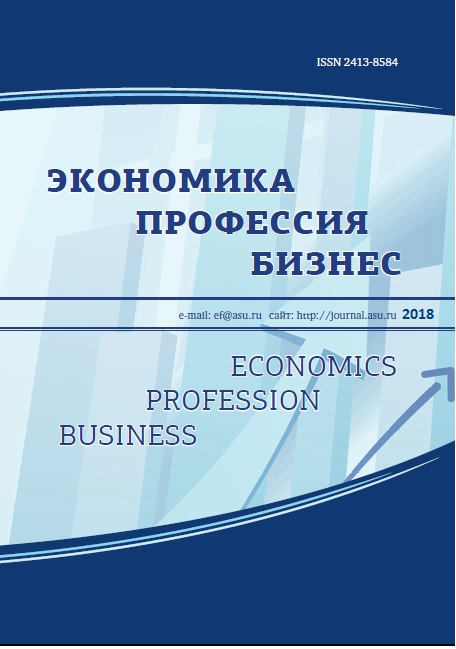MULTIDIMENSIONAL FACTOR SEGMENTATION OF LABOR MARKET SHARE WITH THE PARTICIPATION OF STUDENTS
Abstract
In the article, the need of segmentation of the share of labor market with full-time students as participants is explained. The authors propose a measurement method of the base market, and present a special case of multidimensional factor segmentation grids based on attributes (factors) of the 1st level of the optimization model. The analysis of the obtained segments revealed some features of the relations of different groups of consumers to the factors influencing the employment of students. The authors supplemented the segmentation of the labor market by assessing the consistency of the opinions of experts (students) who fell into the object of the survey.
Downloads
Metrics
References
Dvořáková L., Zborková Ji. Integration of Sustainable Development at Enterprise Level. Procedia Engineering, 2014, vol. 69, pp. 686–695. DOI: 10.1016/j.proeng.2014.03.043.
Hull J. C. Risk Management and Financial Institutions. Wiley, 2015. 742 p.
Затонский А. В., Сиротина Н. А. Прогнозирование экономических систем по модели на основе регрессионного дифференциального уравнения // Экономика и математические методы. 2014. Т. 50. № 1. С. 91–99.
Официальный сайт Федеральной службы государственной статистики. [Электронный ресурс]. URL: http://www.gks.ru.
Родионова А. В. Трудовая занятость студентов в контексте обучения (на примере Санкт-Петербурга) // Теория и практика общественного развития. 2011. № 7.
Shavandina O., Makusheva G., Sulipov R., Kholodenko Yu. Rating Analysis of Identified Segments of a Corporate Organization // Revista Espacios; Vol. 38 (No 51) 2017. P. 5–19.
Харченко В. С. Совмещение работы и учебы в вузе: новые практики или новые смыслы // Вопросы образования. 2013. № 3.
Шавандина О. А. Технологии оценивания компетенций // Вестник Академии экономики и права им. У. А. Джолдасбекова. № 1. Т. 2. Спецвыпуск «Перспективы развития науки в современном мире» : материалы II международной научно-практической конференции, 3 марта 2017 г. / сост.: В. В. Хан, Р. Б. Ержаханова. Талдыкорган, 2017. С. 243–246.
Шавандина О. А., Макушева Г. Н. Востребованные профессии в свете приоритетных направлений модернизации экономики России // Экономика. Профессия. Бизнес. 2016. Спецвып. 2. С. 102–105.
Макушева Г. Н., Шавандина О. А., Харинова О. В. Анализ факторов, влияющих на долю студентов, совмещающих обучение в вузе с трудовой деятельностью // Экономика устойчивого развития. 2018. № 2 (34). С. 213–218.
Маслоу А. Корпоративный менеджмент AbrahamH. Maslow. Motivation and Personality (2nd ed.) N. Y., 1970; СПб., 1999. С. 316.
REFERENCES
Andrush, A. (2012) The Reverse Synergy: Another Way of Thinking. International Journal of Economic Practices and Theories, vol. 2, No 2.
Dvořáková, L. & Zborková, Ji. (2014) Integration of Sustainable Development at Enterprise Level. Procedia Engineering,69, 686–695. DOI: 10.1016/j.proeng.2014.03.043.
Hull, J. C. (2015) Risk Management and Financial Institutions. Wiley, 742.
Zatonsky, A. V. & Sirotina N. A. (2014) Forecasting of economic systems on the basis of regression differential equation. Economics and mathematical methods, vol. 50, No. 1, 91–99 (in Russian).
Official website of the Federal state statistics service. URL: http://www.gks.ru/ (in Russian).
Rodionova, A. V. (2011) Employment of students in the context of training (case study on St. Petersburg). Theory and practice of social development, 7 (in Russian).
Shavandina, O., Makusheva, G, Sulipov, R. & Kholodenko, Yu. (2017) Rating Analysis of Identified Segments of a Corporate Organization. Revista Espacio, vol. 38 (No 51), 5–19.
Kharchenko, V. S. (2013) Combining work and study at the University: new practices or new meanings. Issues of education, 3 (in Russian).
Shavandina, O. A. (2017) Technology assessment competencies. Multi-profile educational-scientificproduction journal “Herald of the Academy of Economics and law. U. A. Dzholdasbekov”, No. 1, vol. 2. Special issue “Prospects for the development of science in the modern world”: Proceedings of the II International scientificpractical conference, March 3, 2017, comp. V. V. Han & R. B. Erzhanova. Taldykorgan, 243–246 (in Russian).
Shavandina, O. A. & Makusheva, G. N. (2016) Demanded professions in the light of the priority directions of modernization of the Russian economy. Economics. Profession. Business: annual scientific journal, special issue 2, 102–105 (in Russian).
Makusheva, G. N., Shavandina, O. A & Harinova O. V. (2018) Analysis of factors affecting the proportion of students who combine education in high school with work. Economics of sustainable development: regional scientific journal, 2 (34), 213–218 (in Russian).
Maslow, А. (1999) Corporate management Abraham H. Maslow. Motivation and Personality (2nd ed.) New York: Harper&Row; Saint Petersburg, 316 (in Russian).
Economics Profession Business is a golden publisher, as we allow self-archiving, but most importantly we are fully transparent about your rights.
Authors may present and discuss their findings ahead of publication: at biological or scientific conferences, on preprint servers, in public databases, and in blogs, wikis, tweets, and other informal communication channels.
Economics Profession Business (EPB) allows authors to deposit manuscripts (currently under review or those for intended submission to EPB) in non-commercial, pre-print servers such as ArXiv.
Authors who publish with this journal agree to the following terms:
- Authors retain copyright and grant the journal right of first publication with the work simultaneously licensed under a Creative Commons Attribution License that allows others to share the work with an acknowledgement of the work's authorship and initial publication in this journal.
- Authors are able to enter into separate, additional contractual arrangements for the non-exclusive distribution of the journal's published version of the work (e.g., post it to an institutional repository or publish it in a book), with an acknowledgement of its initial publication in this journal.
- Authors are permitted and encouraged to post their work online (e.g., in institutional repositories or on their website) prior to and during the submission process, as it can lead to productive exchanges, as well as earlier and greater citation of published work (See The Effect of Open Access).









